Introduction
The aim of this guide is to ensure that firearms are safely handled in order to remove risk to the operator and third parties. This guide links to other guides in the firearms series and to the Risk Assessment guide. The following 5 illustrations describe various ‘stages’ of preparedness of a bolt action sporting rifle routinely encountered in the course of deer management activities.
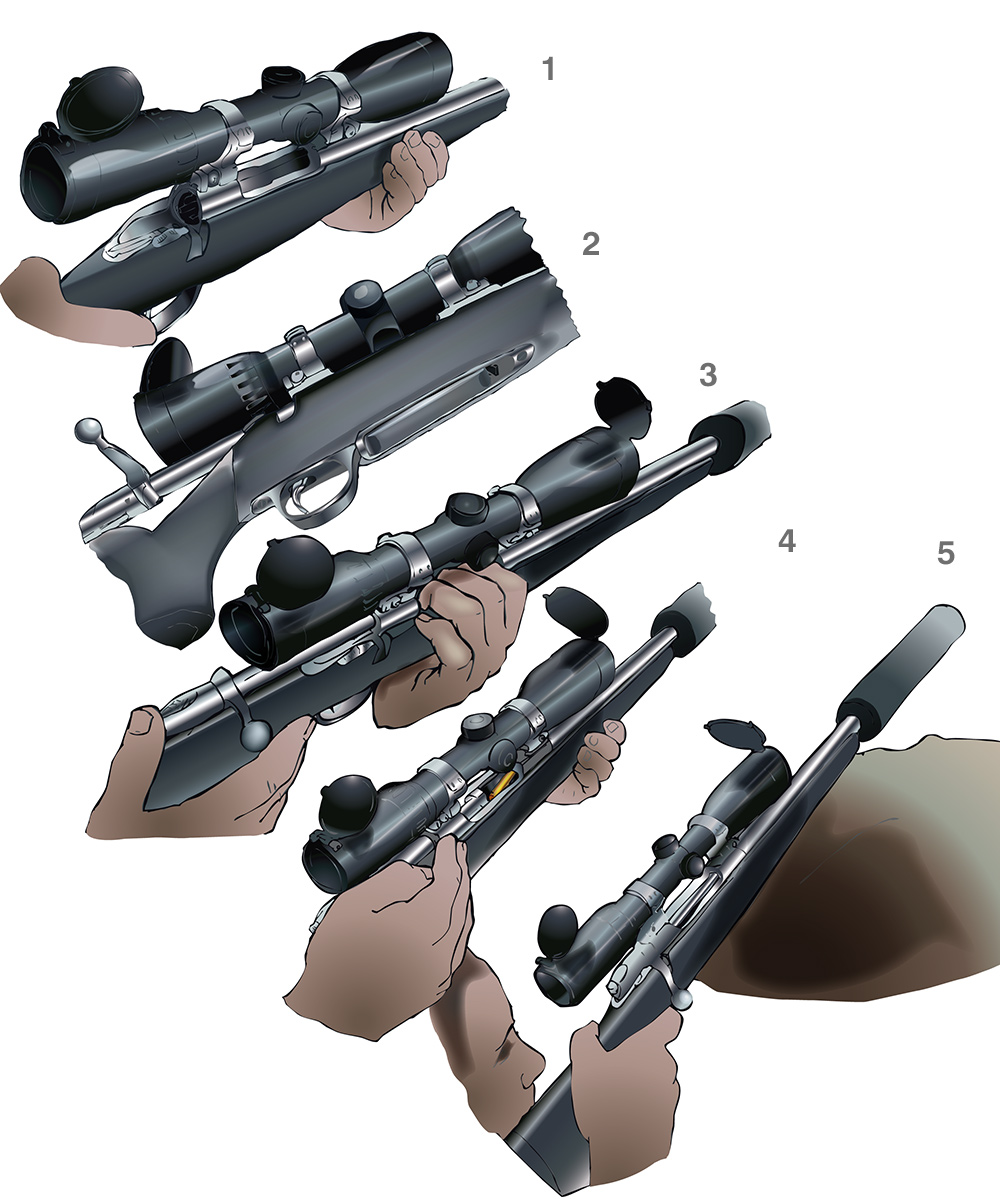
the five preparatory stages
Stage 1: Bolt removed or in place, no rounds in chamber or magazine.
Stage 2: Bolt open, rounds in magazine but not in the chamber.
Stage 3: Bolt closed on empty chamber(fingertip check), safety catch applied, rounds in magazine.
Stage 4: Bolt closed on chambered round, safety catch on (in “safe” position)
Stage 5: Bolt closed on chambered round, safety catch off (in “fire” position)
Terminology
The terminology used in this guide relates only to conventional bolt action sporting rifles. The general safety principles, however, relate to use of all firearms.
Inherent to safe use of firearms is the need to be able to describe accurately to others, the safety status of a rifle. Because the terms ‘loaded’ and ‘unloaded’ may mean different things to different people, the words used to describe the location of rounds in relation to the chamber of a rifle at any given time must be clarified and agreed in advance (see illustrations Stages 1 to 5). The stages are numbered for easy reference throughout this guide.
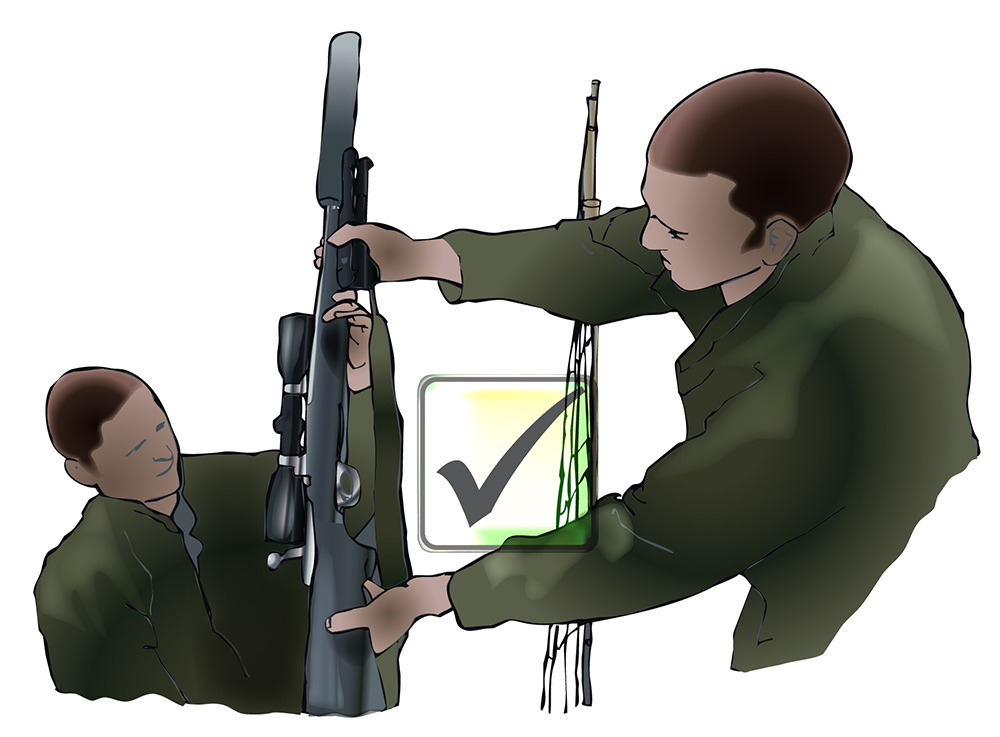
passing over a fence: CORRECTLY ! (note bolt is open)
Health & Safety
The Safety, Health and Welfare Act 2005 covers the use of firearms by employees and those who ‘conduct an undertaking’ involving the use of firearms1. Ensure that an appropriate risk assessment for any activities involving the use of firearms has been carried out and recorded where appropriate2.
Technical competence
A knowledge of how the firearm works and operates is essential. Users must know:
- How the basic parts work;
- How to operate the safety catch;
- How to safely open and close the action;
- How to apply and disengage a set trigger if fitted;
- How to load and remove rounds from the rifle or magazine;
- How to identify the correct ammunition. Carry only the correct ammunition for the firearm and keep it clean, dry and undamaged (in a bullet pouch or spare magazine);
- How to check the firearm is safe to operate (Bolt, safety and trigger operational, bore clear) and if it is the user’s firearm, how to maintain it.
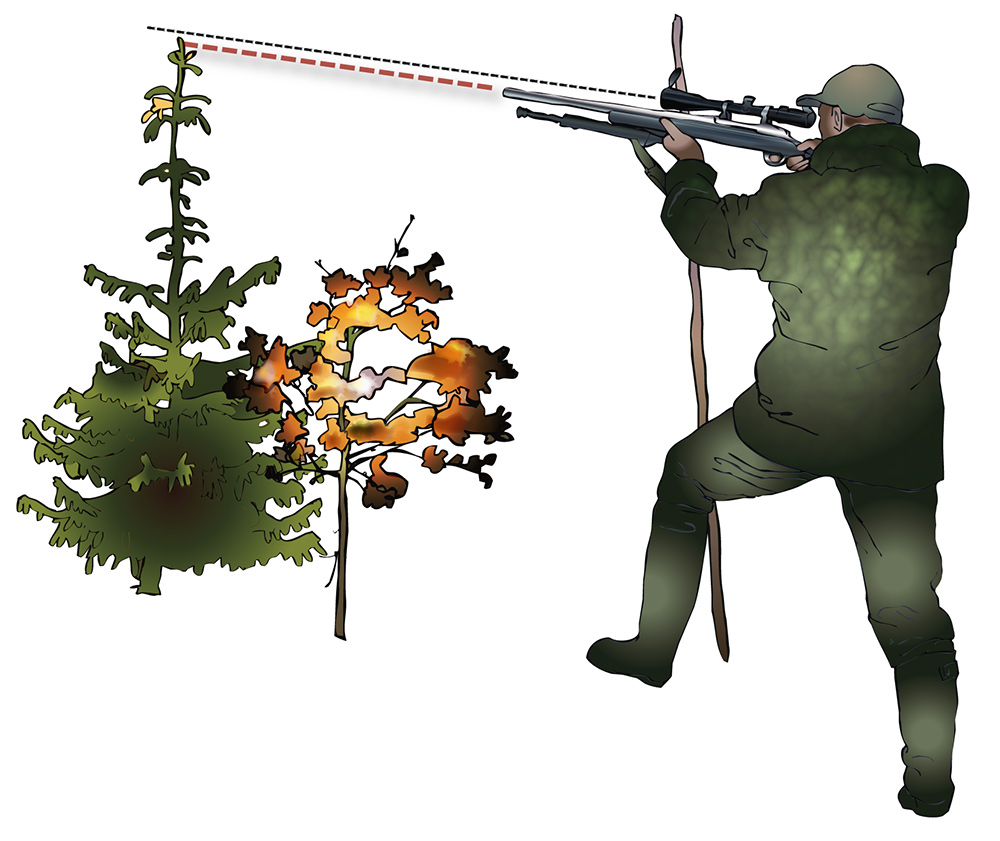
avoid obstructions to the bullet path; note that the top (black dotted) line is the line of sight, whilst the lower (red dashed) line is the actual bullet path
General
- Never allow your firearm to be pointed at anyone.
- Concentrate and remain calm and unhurried when handling firearms.
- Avoid handling firearms while under the influence of alcohol or any drugs.
- Ensure the firearm is pointing in a safe direction at all times, irrespective of load status, so that even if it were to go off, it would not cause injury or damage. This is known as “muzzle awareness”. It is good practice to point out any failures in muzzle awareness of other rifle users.
- Do not use the telescopic sight for spotting potential targets, use binoculars or a telescope.
- Treat all rifles as loaded until you are sure that they are not, even then, the above applies.
- Never rely solely on the safety catch mechanism − it could be faulty or may be accidentally knocked ‘off’.
- Keep fingers off of the trigger at all times except when taking a deliberate shot.
- Know the status of your own, and any other firearm in your presence, at all times.
- Frequently check the status of your firearm and safety catch.
- Inform others when the status of your firearm changes.
- Before giving or receiving a firearm in a non-stalking situation make sure that all involved can see that the bolt is open and the chamber is clear (i.e. the rifle is in Stage 1). When stalking it is acceptable to pass a rifle at stage 2 provided the recipient is made aware that there are rounds in the magazine. Occasionally it may be acceptable to hand over a rifle at stage 3 or 4, for example, when a supervising stalker hands over the rifle to a “client” just before a shot is taken. Ensure that the person receiving the rifle is aware of its status. Rehearse this procedure with a rifle with no bolt and no rounds in chamber or magazine (Stage 1).
- If the rifle is to be carried at Stage 3 check visually and use the tip of a finger to ensure that there is no round in the chamber before fully closing the bolt.
- When loading rounds into the chamber (Stage 4) check that the bore is clear and keep the rifle pointed in a safe direction. It is good practice to always load the same number as this helps to account for all rounds when unloading.
- When stalking, avoid chambering a round (Stage 4 or 5) until the last possible moment. This will vary according to circumstances, for example, it is normal to carry the rifle at stage 4 while woodland stalking on foot but that would not be appropriate for carrying a rifle in a vehicle.
- If stalking with a rifle at Stage 4, keep the rifle slung securely over one shoulder and ensure it is kept pointing at the ground or into the sky at all times. Periodically check the safety catch position and that the bore does not become obstructed by foreign objects.
- When crawling with a rifle in Stage 4, ensure that the rifle remains in a safe state throughout, prevent the trigger and safety catch from becoming entangled and keep the muzzle free from foreign objects. In company the person in front carries the rifle and keeps it pointing forwards. When crawling, a purpose made muzzle cap, or a piece of tape or cling film, is strongly recommended on non-moderated rifles.
- If the bore becomes obstructed, remove the bolt and rounds in the chamber and magazine (Stage 1) and clean the rifle properly3 before further use.
- When unloading the rifle (from Stage 4 or 5 to stage 1 or 2) ensure that it is pointed in a safe direction. Count the rounds out of the rifle and magazine and account for them all. Check visually or with a finger tip that the chamber is empty.
Giving/receiving a firearm
In non-stalking situations:
- When picking up any firearm, always check that it is at Stage 1.
- Before giving or receiving a firearm make sure that all involved know that the rifle is at Stage 1 and is safe.
When stalking:
It is acceptable to pass a rifle at stage 2 provided the recipient is made aware that there are rounds in the magazine. Occasionally it may be acceptable to hand over a rifle at stage 3 or 4, for example, when a supervising stalker hands over the rifle to a “client” just before a shot is taken. Ensure that the person receiving the rifle is aware of its status. Rehearse this procedure with a rifle with no bolt and no rounds in chamber or magazine (Stage 1). On no account should a rifle be passed while at Stage 5.
Negotiating obstacles/other situations
Ensure the rifle chamber is empty (Stage 1, 2 or 3) and the status of the rifle is known by all present before:
- Crossing any major obstacle (i.e. fence, stream, ditch), see Fig 2. ;
- Laying down a rifle (ensure that the muzzle and action cannot pick up foreign objects);
- Climbing into a high seat;
The rifle must be at stage 1 and the status of the rifle known by all present when:
- Entering a vehicle;
- Entering a building;
- Engaging in conversation with members of the public while stalking;
- Entering an area where you do not intend to shoot.
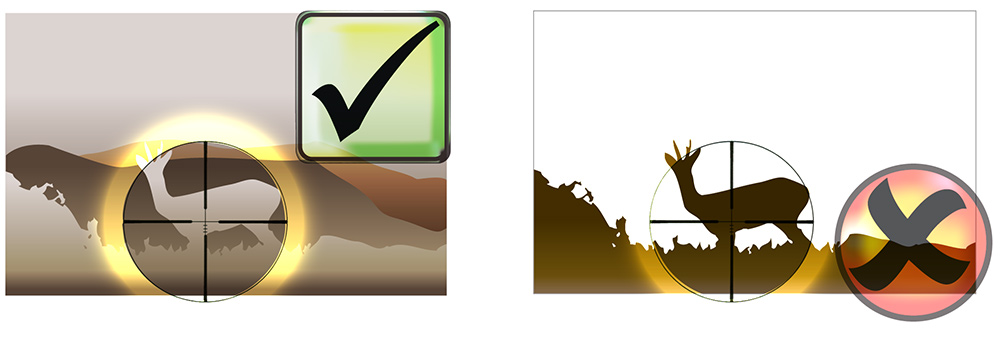
(left) safe, no obstructions in front, no unseen ground between target and solid backstop; (right) skyline shots are never safe because there is no safe backstop
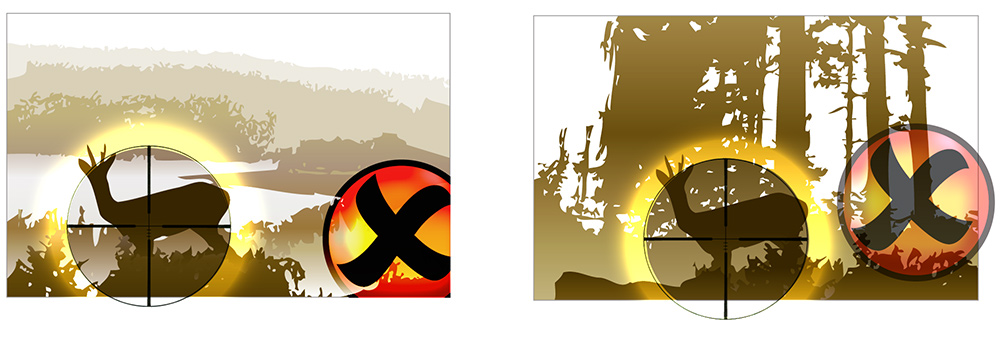
(left) the round, or fragments of the round, may ricochet off the water behind; (right) trees or hedges alone do not make a good backstop, as they may cause ricochet or obscure something you do not mean to shoot at
Taking a shot
- Be familiar with the surroundings and know where potential hazards are.
- Ensure targets have been identified beyond any doubt.
- Ensure there are no obstructions in the path of the bullet, see Fig 3. Even small twigs can cause deflections or ricochet, the closer to the rifle the obstruction is, the greater the effect on the bullet path. Be aware that the bullet does not precisely follow the line of sight at all distances6.
- Before taking a shot ensure that the backstop/background is safe and that it remains safe if the target or shooter moves. A safe backstop is one that could reasonably be expected to capture a bullet and bullet fragments without causing ricochet, damage or danger. See Fig 4.
- Ensure that non-target animals will be not hit by the bullet or fragments as the bullet exits the target.
- Keep your finger off the trigger until ready to fire.
- If shooting from a vehicle, a round should only be chambered (Stage 4) when the muzzle is located outside the vehicle, just before a shot is taken.
- Only disengage the safety catch(changing from Stage 4 to Stage 5) when the rifle is in a stable position, pointed in a safe direction and when the shot is about to be taken.
- Re-apply the safety if at Stage 5 and the opportunity for a shot passes or after re-loading.
- When moving forward after a shot is taken, make sure the rifleman leads, so that a follow-up shot could be taken safely should it be required.
Hearing protection
- Ensure that hearing protection is worn where required and that others in close proximity also do so.
- Even when sound moderators are in use, seek guidance1 on wearing hearing protection in the presence of firearms.
- For employees ensure that levels of noise conform to The Safety, Health and Welfare at Work (Control of Noise at Work) Regulations (SI No 371 0f 2006).
- Dogs are particularly sensitive to loud noise, keep them away from muzzle blast.
Misfire
- Transfer aim to a safe direction. Maintain a firm grip throughout this procedure.
- Alert others if applicable.
- Examine the rifle. If the firing pin has not fallen or the bolt handle is not fully down be aware that moving the bolt or safety catch could cause the gun to fire. With the rifle in a safe direction push the bolt handle firmly down, then move the safety catch to safe.
- Wait at least 20 seconds.
- Ensure that the cartridge can be found when ejected.
- With rifle pointing in safe direction move the safety to the fire position. Hold your face away from the breech and your fingers in front of the bolt (so that it flies away from your hand if there is an explosion). Lift the bolt swiftly and cleanly upwards by the fingertips, minimising the body parts that might be exposed if a blast from the chamber occurs.
- Clear the rifle (stage1), check that the barrel is clear and put the rifle in a safe place.
- Retrieve the cartridge and examine it. If there is no firing pin indent suspect a fault with the rifle. If the primer has a normal indent it may be a cartridge fault, wrap the cartridge in soft material, carry in an outer pocket and dispose of safely.
Storage
- When stalking is over the rifle should be placed in a sleeve or case, at Stage 1. The bolt can be closed if stored temporarily with the rifle, but must be removed if the rifle is left unattended.
- Unattended rifles must be securely stored to prevent unauthorised access, see Firearms Security guide.
Further Info
- Health and Safety at Work Act 1974 – http://www.hse.gov.uk/legislation/hswa.pdf
- See Risk Assessment guide
- See Rifle Maintenance guide
- Control of noise at work Regulations 2005 – http://www.opsi.gov.uk/si/si2005/20051643.htm
- See Transport and Storage guide
- See Rifles and Ammunition and Marksmanship guides.
[printfriendly]